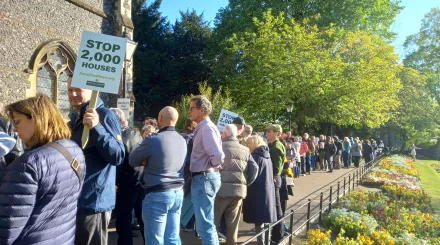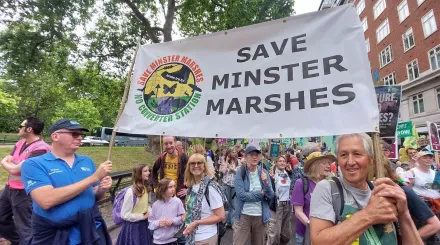Step one – find out what the score is
How did you find out about the development in the first place? Was it a rumour, or something more substantial? Check out the planning portal on your local council’s website and make sure your facts are correct. Once you have done that, drop the planning department an email to find out about significant timelines within the process so you can plan accordingly.

Step two – people power
Step three – head to the Kent Planning Network for Nature
The Kent Planning Network for Nature is a relatively new online resource which has been created by planning officers and campaigners from a number of conservation organisations, including Kent Wildlife Trust. Here you can share information on your campaign and tap into valuable resources and information to help you navigate the planning system.
Step four – create your communications strategy
Define what your ultimate outcome should be, and how you are going to achieve this. Create a small number of key concerns as to why the development should not go ahead and select ones that a developer would struggle to mitigate against - for example, loss of habitat, loss of rare species, loss of high-grade arable land, river pollution.
Give your campaign a name. Ideally you should choose something that is positive, such as ‘Save XXX Wood’ rather than ‘Stop XXX Development’. The latter has negative connotations and would promote the name of the development. Your focus should be on saving green space for our mental health and wellbeing and saving wildlife.

Create a logo
Step five – money, money, money!
Consider setting up a Crowd Justice funder at an early stage. Whilst you may not require legal aid at this point, you can use a proportion of the money to help with campaign costs such as graphic design, websites, and video/photography costs as the campaign develops. In the case the money is not needed, you could donate it to a conservation charity, like Kent Wildlife Trust, so that our expert planning and policy team can continue to actively engage with planning processes to oppose developments that put wildlife at risk.
Step six – spread the word
You now have your campaign name, your goals and concerns and hopefully a merry band of like-minded people ready to take action. Now you’re ready to shout about it!
It is helpful to set up a website page which spells out who you are, what you want to happen and why. You can also use your website to signpost people to any Crowd Justice funders you have set up and your supporting social media accounts.
Create a public facing Facebook and X account for your campaign and select some internet savvy people from your group to manage it. You may even want to consider setting up an Instagram or TikTok account too - but remember, the more accounts you have, the more you need to manage them!
Follow like-minded campaign groups and organisations and boldly ask them to share your messages. Don’t be shy, contact conservation charities like Kent Wildlife Trust and ask us for our support. You can then highlight on your website that your campaign is endorsed by these organisations.
Do some research, investigate your local online news outlets and ask them to give you the contact of their reporter for your area so you can send them a press release about your group and your concerns. It is also worth doing the same for your regional TV and radio stations too. You’ll be surprised at how much interest you can generate with a bit of leg work.
The golden rule – keep it positive
It is important to keep your messaging positive. Whilst it is an emotive subject, you are trying to attract support from the general public. Anything that comes across as NIMBYism (Not In My Back Yard) will struggle to win public support. Concentrate on what is at risk rather than making accusations against the developer. For example, if there is a red-list species in the area, highlight its plight and why it is important or how the green space is much-needed for people’s mental health.
Groups like Save Oaken Wood and Save Swanscombe run guided walks, talking people through the precious wildlife living in their at-risk nature haven. This is a fantastic way to show the community why your wildlife must be saved and bring them closer to nature.
Some good examples
Kent Wildlife Trust is lucky to work with a number of fantastic campaign groups. Take the time to look at their work and what they have achieved. It may also be useful to reach out to them and see what advice they may have for you – they're a pretty great bunch of people!
One last thing…
There is one more thing you can do to help us: donate to our “Save our Woodlands” appeal. This appeal covers a broad range of our work, including the work we do to save our precious woodlands. Our small planning team work tirelessly creating strong cases for the preservation of woodlands under threat of development. By donating today, you are helping us in continuing with this often overlooked, but much-needed element of our work.

